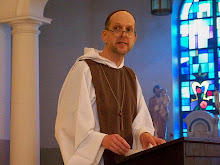What follows is a Mediation I gave on Friday, March 12 at The Episcopal Church of the Atonement in Chicago - between Stations of the Cross and Benediction. March 12 is also The Feast of Saint Gregory the Great.

“O all ye that pass by the way, stop, and consider………..”
These are the words that begin the meditation of the Thirteenth Station “The Body of Jesus is Placed in the Arms of this Mother.”
What is evident in this short phrase is one “passing by the way” and that one is exhorted to “stop, and consider…..”
Here we are. Passing by the way. The Way of the Cross.
Just what is this Way of the Cross? Father John David has a good summary I encourage you to read in the cover of the service leaflet. What I want to add particularly was that in ancient times of the church there were no “stations of the cross” rather, those who could would make a pilgrimage specifically to the Holy Land. These people would visit the sites believed to be places where events leading to Christ’s Passion happened. As centuries passed and especially as Jerusalem fell to the Turks, recreations of these sites appeared in western Europe, and making a pilgrimage to them, and making a pilgrimage within these sites was considered as good as traveling to The Holy Land. There weren’t always fourteen stations. Many traditions came and went over the centuries. Sometimes there were as few as eleven. Some places had as many as thirty-seven. As in anything regarding the church there were great arguments about them. Some said they focused too much on Mary. Some said not enough Mary. The fourteen stations of the cross as we know them wasn’t established until about the end of the seventeenth century – with a nice blend of both Christ and Mary.
The number of stations is not as important - as us just merely walking the steps and then stopping to consider.
You will find in most churches that Stations of The Cross are arranged in a counter-clockwise order. This was to be the opposite of pagan traditions of going in clock-wise or sun-wise direction – left-to-right if facing south.
“O all ye that pass by the way, stop, and consider………..”
Here we are – on our Lenten sojourn.
Here we are, about half-way through; nearly, but not yet at the time of refreshment this coming Gaudate Sunday.
Where are we on our pilgrimage of Lent?
<>
Today is also auspiciously and coincidently the Feast of Saint Gregory the Great. A Feast within our Great Fast. Saint Gregory the Great is the Patron Saint of The Brotherhood of Saint Gregory, a canonically recognized religious community of men within The Episcopal Church. Myself, Br Ronald Augustine, Br. Will, and Br. William Henry are part of this religious community. Gregory the Great is the patron saint of musicians, singers, students, and teachers.
Saint Gregory the great was born in the mid-sixth century in Rome to a family of some privilege – his father a Roman politician. He was born at a time when the Goths would invade and sack Rome repeated times. His family was likely exiled but returned to Rome – where when Gregory’s Father was still alive, Gregory would become Prefect – or rather Mayor and Operations Manager of Rome all at the same time. Gregory was later made ambassador to the East traveling to Constantinople. Gregory participated fully in monasticism he found both in Rome and in the East. Gregory was hoping to retire into a life of monasticism and prayer…. But in 590 Pope Pelagius had succumbed to the plague and Gregory was elected Pope by acclamation – rather unwillingly.
Gregory the Great holds great meaning for Anglicans. Particularly, Gregory’s time was of great disease and political strife. Gregory was able to breath life back into missions of the church particularly to evangelize the pagan Anglo-Saxons of England by sending Augustine – who we know as Saint Augustine of Canterbury.
Contemporary author, editor, composer, and choral director J. Michael Thompson in his Treatise on Gregory notes:
In other words Gregory was not only a man in the middle, much like we are in the middle of Lent, but also living at a time of tumultuous change, much like our current social upheavals.
If Gregory were amongst us today, he would not recognize Stations of the Cross, but he would certainly recognize the Pilgrimage in the Holy Land and the importance they represent.
Gregory would not recognize Benediction of The Blessed Sacrament as a particular liturgy, this wouldn’t come until the thirteenth century. Gregory would recognize the importance of the blessedness and the veneration.
If Gregory were amongst us today, what he would recognize most of all is our observation of a Holy Lent.
In one of Gregory the Great’s recorded homilies, particularly on Lent, Gregory says
“Let us who have fallen away from the joys of paradise through food, rise up to them again, as much as we can, though fasting. But no one alone should believe that this fast alone can suffice for him, the Lord says through the prophet [Isaiah] I have not chosen such a fast, instead, break your bread for the hungry, and bring the vagrants and needy into your homes. If you see someone naked clothe him, and do not turn away your own kin.
Where have we been on our pilgrimage? Where are we going? Why am I here?
“O all ye that pass by the way, stop, and consider………..”
SOLI DEO GLORIA
These are the words that begin the meditation of the Thirteenth Station “The Body of Jesus is Placed in the Arms of this Mother.”
What is evident in this short phrase is one “passing by the way” and that one is exhorted to “stop, and consider…..”
Here we are. Passing by the way. The Way of the Cross.
Just what is this Way of the Cross? Father John David has a good summary I encourage you to read in the cover of the service leaflet. What I want to add particularly was that in ancient times of the church there were no “stations of the cross” rather, those who could would make a pilgrimage specifically to the Holy Land. These people would visit the sites believed to be places where events leading to Christ’s Passion happened. As centuries passed and especially as Jerusalem fell to the Turks, recreations of these sites appeared in western Europe, and making a pilgrimage to them, and making a pilgrimage within these sites was considered as good as traveling to The Holy Land. There weren’t always fourteen stations. Many traditions came and went over the centuries. Sometimes there were as few as eleven. Some places had as many as thirty-seven. As in anything regarding the church there were great arguments about them. Some said they focused too much on Mary. Some said not enough Mary. The fourteen stations of the cross as we know them wasn’t established until about the end of the seventeenth century – with a nice blend of both Christ and Mary.
The number of stations is not as important - as us just merely walking the steps and then stopping to consider.
You will find in most churches that Stations of The Cross are arranged in a counter-clockwise order. This was to be the opposite of pagan traditions of going in clock-wise or sun-wise direction – left-to-right if facing south.
“O all ye that pass by the way, stop, and consider………..”
Here we are – on our Lenten sojourn.
Here we are, about half-way through; nearly, but not yet at the time of refreshment this coming Gaudate Sunday.
Where are we on our pilgrimage of Lent?
<>
Today is also auspiciously and coincidently the Feast of Saint Gregory the Great. A Feast within our Great Fast. Saint Gregory the Great is the Patron Saint of The Brotherhood of Saint Gregory, a canonically recognized religious community of men within The Episcopal Church. Myself, Br Ronald Augustine, Br. Will, and Br. William Henry are part of this religious community. Gregory the Great is the patron saint of musicians, singers, students, and teachers.
Saint Gregory the great was born in the mid-sixth century in Rome to a family of some privilege – his father a Roman politician. He was born at a time when the Goths would invade and sack Rome repeated times. His family was likely exiled but returned to Rome – where when Gregory’s Father was still alive, Gregory would become Prefect – or rather Mayor and Operations Manager of Rome all at the same time. Gregory was later made ambassador to the East traveling to Constantinople. Gregory participated fully in monasticism he found both in Rome and in the East. Gregory was hoping to retire into a life of monasticism and prayer…. But in 590 Pope Pelagius had succumbed to the plague and Gregory was elected Pope by acclamation – rather unwillingly.
Gregory the Great holds great meaning for Anglicans. Particularly, Gregory’s time was of great disease and political strife. Gregory was able to breath life back into missions of the church particularly to evangelize the pagan Anglo-Saxons of England by sending Augustine – who we know as Saint Augustine of Canterbury.
Contemporary author, editor, composer, and choral director J. Michael Thompson in his Treatise on Gregory notes:
In the modern era, Gregory is often depicted as a man at the border, poised between the Roman and Germanic worlds, between East and West, and above all, perhaps, between the ancient and medieval epochs.
In other words Gregory was not only a man in the middle, much like we are in the middle of Lent, but also living at a time of tumultuous change, much like our current social upheavals.
If Gregory were amongst us today, he would not recognize Stations of the Cross, but he would certainly recognize the Pilgrimage in the Holy Land and the importance they represent.
Gregory would not recognize Benediction of The Blessed Sacrament as a particular liturgy, this wouldn’t come until the thirteenth century. Gregory would recognize the importance of the blessedness and the veneration.
If Gregory were amongst us today, what he would recognize most of all is our observation of a Holy Lent.
In one of Gregory the Great’s recorded homilies, particularly on Lent, Gregory says
“Let us who have fallen away from the joys of paradise through food, rise up to them again, as much as we can, though fasting. But no one alone should believe that this fast alone can suffice for him, the Lord says through the prophet [Isaiah] I have not chosen such a fast, instead, break your bread for the hungry, and bring the vagrants and needy into your homes. If you see someone naked clothe him, and do not turn away your own kin.
Where have we been on our pilgrimage? Where are we going? Why am I here?
“O all ye that pass by the way, stop, and consider………..”
SOLI DEO GLORIA







No comments:
Post a Comment